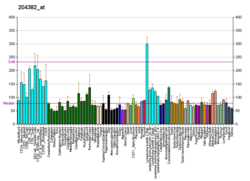| NAT9 |
|---|
|
| Identifiers |
|---|
| Aliases | NAT9, EBSP, hNATL, N-acetyltransferase 9 (putative) |
|---|
| External IDs | MGI: 1913426; HomoloGene: 9231; GeneCards: NAT9; OMA:NAT9 - orthologs |
|---|
| Gene location (Human) |
|---|
 | | Chr. | Chromosome 17 (human)[1] |
|---|
| | Band | 17q25.1 | Start | 74,770,529 bp[1] |
|---|
| End | 74,776,367 bp[1] |
|---|
|
| Gene location (Mouse) |
|---|
 | | Chr. | Chromosome 11 (mouse)[2] |
|---|
| | Band | 11|11 E2 | Start | 115,182,832 bp[2] |
|---|
| End | 115,187,859 bp[2] |
|---|
|
| RNA expression pattern |
|---|
| Bgee | | Human | Mouse (ortholog) |
|---|
| Top expressed in | - anterior pituitary
- right adrenal gland
- left adrenal cortex
- right adrenal cortex
- right ovary
- left ovary
- right hemisphere of cerebellum
- right lobe of thyroid gland
- left lobe of thyroid gland
- canal of the cervix
|
| | Top expressed in | - spermatocyte
- seminiferous tubule
- granulocyte
- spermatid
- neural layer of retina
- right kidney
- muscle of thigh
- yolk sac
- proximal tubule
- left lobe of liver
|
| | More reference expression data |
|
|---|
| BioGPS |  | | More reference expression data |
|
|---|
|
| Gene ontology |
|---|
| Molecular function | - transferase activity
- acyltransferase activity
- protein binding
- acyltransferase activity, transferring groups other than amino-acyl groups
- N-acetyltransferase activity
| | Cellular component | - protein-containing complex
| | Biological process | - N-terminal protein amino acid acetylation
- protein acetylation
| | Sources:Amigo / QuickGO |
|
| Orthologs |
|---|
| Species | Human | Mouse |
|---|
| Entrez | | |
|---|
| Ensembl | | |
|---|
| UniProt | | |
|---|
| RefSeq (mRNA) | NM_001305077
NM_001305078
NM_001305079
NM_001305080
NM_001305081
|
|---|
NM_001305082
NM_001305083
NM_001305084
NM_001305085
NM_001305086
NM_001305087
NM_001305088
NM_015654 |
| |
|---|
| RefSeq (protein) | NP_001292006
NP_001292007
NP_001292008
NP_001292009
NP_001292010
|
|---|
NP_001292011
NP_001292012
NP_001292013
NP_001292014
NP_001292015
NP_001292016
NP_001292017
NP_056469 |
| |
|---|
NP_079676
NP_001349818
NP_001349819
NP_001349820
NP_001349821 |
|
|---|
| Location (UCSC) | Chr 17: 74.77 – 74.78 Mb | Chr 11: 115.18 – 115.19 Mb |
|---|
| PubMed search | [3] | [4] |
|---|
|
| Wikidata |
| View/Edit Human | View/Edit Mouse |
|


















